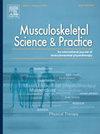Structural brain alterations and clinical associations in individuals with chronic nonspecific neck pain
IF 2.2
3区 医学
Q1 REHABILITATION
引用次数: 0
Abstract
Background
Chronic pain is associated with changes in brain structures. However, the specific morphological changes in chronic nonspecific neck pain (CNSNP) are still unclear.
Objectives
To investigate altered brain morphology in patients with CNSNP and its relationships with clinical characteristics of neck pain.
Design
Cross-sectional study.
Methods
Thirty CNSNP and 30 controls underwent T1-weighted structural MRI to assess whole-brain vertex-wise cortical thickness and gray matter volume. Between-group differences were determined using cluster-wise correction for multiple comparisons and analyses of global structure and pain-related regions of interest (ROIs). Pain outcomes were neck pain duration, intensity, disability and pressure pain thresholds (PPTs) over the cervical spine.
Results
Overall, the cluster-wise analysis revealed increased cortical thickness and decreased gray matter volume in several brain regions such as the precuneus, supramarginal gyrus and parietal cortex in the neck pain group (CWP<0.05). The global analysis showed that the neck pain group had increased total thickness and decreased total volume (p < 0.05). The ROI analysis showed that the neck pain group exhibited increased thickness in the primary somatosensory cortex (S1), anterior cingulate cortex (ACC) and precuneus and decreased volume in the prefrontal cortex (PFC), S1, ACC and insula compared to controls (adjusted p-values<0.05). Reduced insula volume correlated with greater neck disability (r = −0.53, adjusted p-value<0.01). Increased PPTs correlated with greater S1 and precuneus thickness (r = 0.46−0.48, adjusted p-values<0.05) and S1 volume (r = 0.53−0.58, adjusted p-values<0.05).
Conclusion
Patients with CNSNP exhibited increased cortical thickness and decreased gray matter volume in brain regions involved in pain processing and emotional and cognitive responses.
慢性非特异性颈痛患者脑结构改变及临床关系
背景:慢性疼痛与大脑结构的改变有关。然而,慢性非特异性颈痛(CNSNP)的具体形态学改变尚不清楚。目的探讨CNSNP患者脑形态改变及其与颈部疼痛临床特征的关系。DesignCross-sectional研究。方法对30例CNSNP患者和30例对照组进行t1加权结构MRI检查,评估全脑顶点方向皮质厚度和灰质体积。通过对全局结构和疼痛相关感兴趣区域(roi)的多重比较和分析,使用聚类校正来确定组间差异。疼痛结局是颈部疼痛持续时间、强度、残疾和颈椎压痛阈值(PPTs)。结果总体而言,聚类分析显示,颈痛组的楔前叶、边缘上回和顶叶皮质等脑区皮质厚度增加,灰质体积减少(CWP<0.05)。整体分析显示,颈痛组总厚度增加,总体积减小(p <;0.05)。ROI分析显示,与对照组相比,颈痛组初级体感皮层(S1)、前扣带皮层(ACC)和楔前叶厚度增加,前额叶皮层(PFC)、S1、ACC和脑岛体积减少(调整p值0.05)。脑岛体积减小与颈部残疾加重相关(r = - 0.53,校正p值<;0.01)。PPTs升高与S1和楔前叶厚度增大(r = 0.46 - 0.48,调整p值<;0.05)和S1体积增大(r = 0.53 - 0.58,调整p值<;0.05)相关。结论CNSNP患者在与疼痛加工、情绪和认知反应有关的脑区表现为皮层厚度增加、灰质体积减少。
本文章由计算机程序翻译,如有差异,请以英文原文为准。
求助全文
约1分钟内获得全文
求助全文
来源期刊

Musculoskeletal Science and Practice
Health Professions-Physical Therapy, Sports Therapy and Rehabilitation
CiteScore
4.10
自引率
8.70%
发文量
152
审稿时长
48 days
期刊介绍:
Musculoskeletal Science & Practice, international journal of musculoskeletal physiotherapy, is a peer-reviewed international journal (previously Manual Therapy), publishing high quality original research, review and Masterclass articles that contribute to improving the clinical understanding of appropriate care processes for musculoskeletal disorders. The journal publishes articles that influence or add to the body of evidence on diagnostic and therapeutic processes, patient centered care, guidelines for musculoskeletal therapeutics and theoretical models that support developments in assessment, diagnosis, clinical reasoning and interventions.
 求助内容:
求助内容: 应助结果提醒方式:
应助结果提醒方式:


